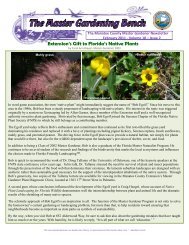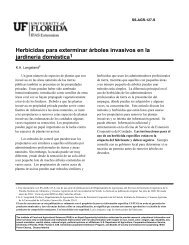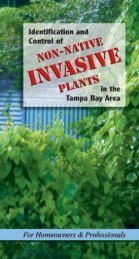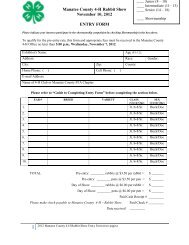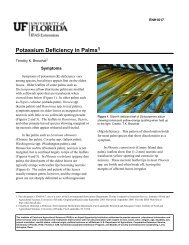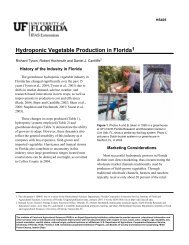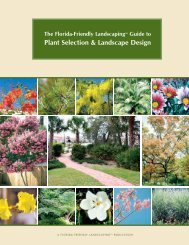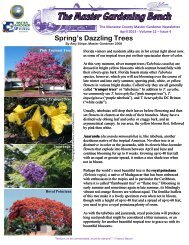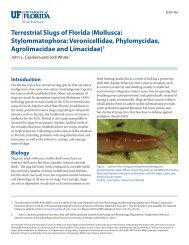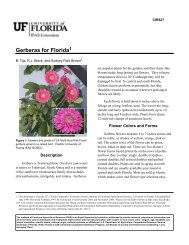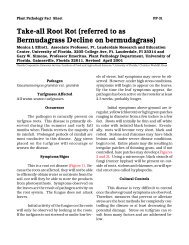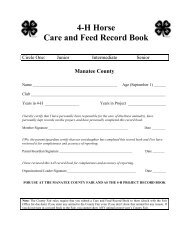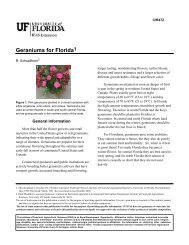Petiole (Rachis) Blight of Palm - Manatee County Extension Office ...
Petiole (Rachis) Blight of Palm - Manatee County Extension Office ...
Petiole (Rachis) Blight of Palm - Manatee County Extension Office ...
You also want an ePaper? Increase the reach of your titles
YUMPU automatically turns print PDFs into web optimized ePapers that Google loves.
<strong>Petiole</strong> (<strong>Rachis</strong>) <strong>Blight</strong> <strong>of</strong> <strong>Palm</strong> 2name <strong>of</strong> these diseases became “rachis blight.”However, as we now know, palms that do not have arachis also are susceptible to petiole diseases. In thisfact sheet the disease will be referred to as "petioleblight."In general, the “typical” or “classic” petioleblight is a disease in which the pathogen only infectsthe petiole. The disease symptoms may look like thepathogen has also infected the leaf blade, but this is asecondary affect from petiole infection. Anexception to the “typical” petiole blight is a diseasecaused by Pestalotiopsis. This pathogen causes botha leaf spot and blight as well as a petiole or rachisblight, usually at the same time. It is discussed in aseparate fact sheet at http://edis.ifas.ufl.edu/pp141.Pathogens and HostsThere are a number <strong>of</strong> different pathogensassociated with petiole blight. These includeCocoicola and Serenomyces, which are only found inassociation with palms. Macrophoma, Phoma,Phomopsis, Diplodia, and Pestalotiopsis may alsocause this disease, but these fungi also cause diseases<strong>of</strong> numerous other plant hosts. The host range <strong>of</strong> all<strong>of</strong> these fungi within the palm family is unknown.SymptomsFigure 1. Overview <strong>of</strong> Washingtonia robusta group: Thecenter palm is severely affected by <strong>Petiole</strong> <strong>Blight</strong> causedby Cocoicola. Credits: A. Wilsondestroyed vascular tissue are killed (Figure 4). Thisresults in a one-sided or uneven death <strong>of</strong> the leafblade, the symptom most <strong>of</strong>ten observed first. ForPhoenix canariensis (Canary Island date palm), thesesymptoms are quite similar to those caused byFusarium wilt. See the fact sheet on this disease athttp://edis.ifas.ufl.edu/pp139.Mature palms (palms with trunks) are morelikely to be affected by petiole blight than juvenilepalms. On mature palms, the oldest (lowest) livingleaves will be affected first. The disease will move upthrough the canopy to younger leaves. The diseasemay severely debilitate the palm, but the diseaseseldom kills the palm (Figure 1).No matter which pathogen is causing the disease,the symptoms <strong>of</strong> petiole blight are essentially thesame. Discolored (usually brown or reddish-brown)elongated lesions or streaks <strong>of</strong>ten occur along thepetiole and rachis (Figures 2 and 3). The fungusinvades deep into the petiole and is destroying alltissue, including the vascular tissue (xylem andphloem). This vascular tissue moves water andcarbohydrates between the leaf and the stem (trunk).Vascular tissue destroyed in the petiole or rachisresults in localized death in the leaf blade becauseonly the leaf segments or leaflets connected to theFigure 2. Reddish-brown streak along petiole <strong>of</strong>Washingtonia robusta due to <strong>Petiole</strong> <strong>Blight</strong>. Credits: A.WilsonAgain, while it appears the fungus is alsoinfecting the leaf blade, it does not. The leaf bladesymptoms are a result <strong>of</strong> the fungal damage in the



